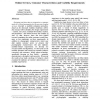Free Online Productivity Tools
i2Speak
i2Symbol
i2OCR
iTex2Img
iWeb2Print
iWeb2Shot
i2Type
iPdf2Split
iPdf2Merge
i2Bopomofo
i2Arabic
i2Style
i2Image
i2PDF
iLatex2Rtf
Sci2ools
HICSS
2008
IEEE
2008
IEEE
Online Services, Customer Characteristics and Usability Requirements
Designing web sites that are responsive to customer needs is a critical prerequisite for the success of online services. Recently, a usability evaluation procedure, based on the Microsoft Usability Guidelines (MUG) has emerged. MUG identifies five design requirements – content, ease of use, made-for-the-medium, emotion, and promotion – that should increase the usability of sites. To date, however, there has been limited research examining why online customers would place more or less importance on these requirements. In addition to demographic characteristics which may help explain customer needs, we propose that psychographic characteristics will also influence usability-related requirements. To develop our research model and hypotheses, we draw from recent usability literature and research in consumer behavior concerned with customers’ beliefs about technology, specifically focusing on four beliefs – optimism, innovativeness, discomfort, and insecurity. We present the result...
Biometrics | Customer Needs | HICSS 2008 | System Sciences | Usability | Usability Evaluation Procedure |
| Added | 29 May 2010 |
| Updated | 29 May 2010 |
| Type | Conference |
| Year | 2008 |
| Where | HICSS |
| Authors | Anne P. Massey, Vijay Khatri, Mitzi M. Montoya-Weiss |
Comments (0)

